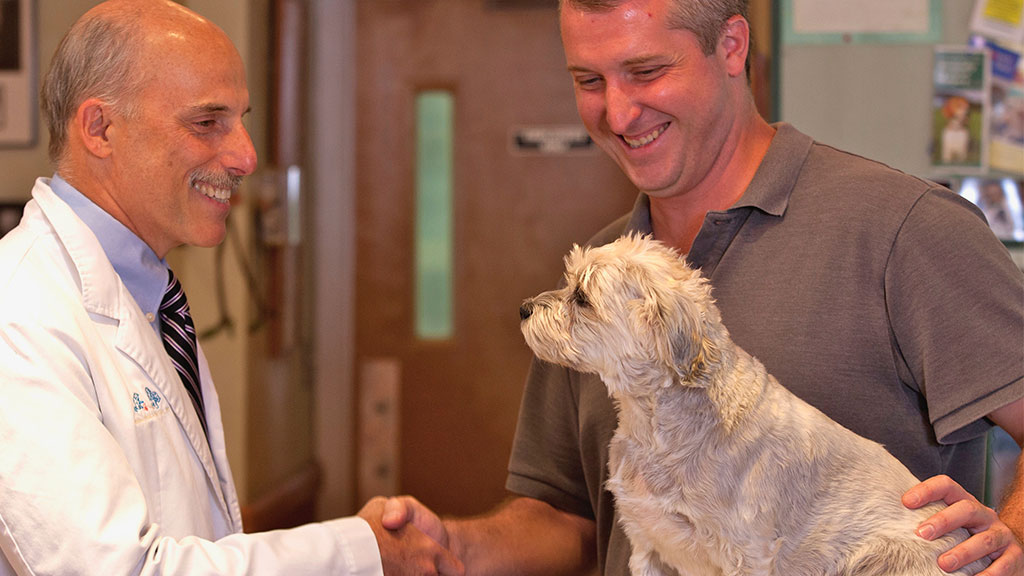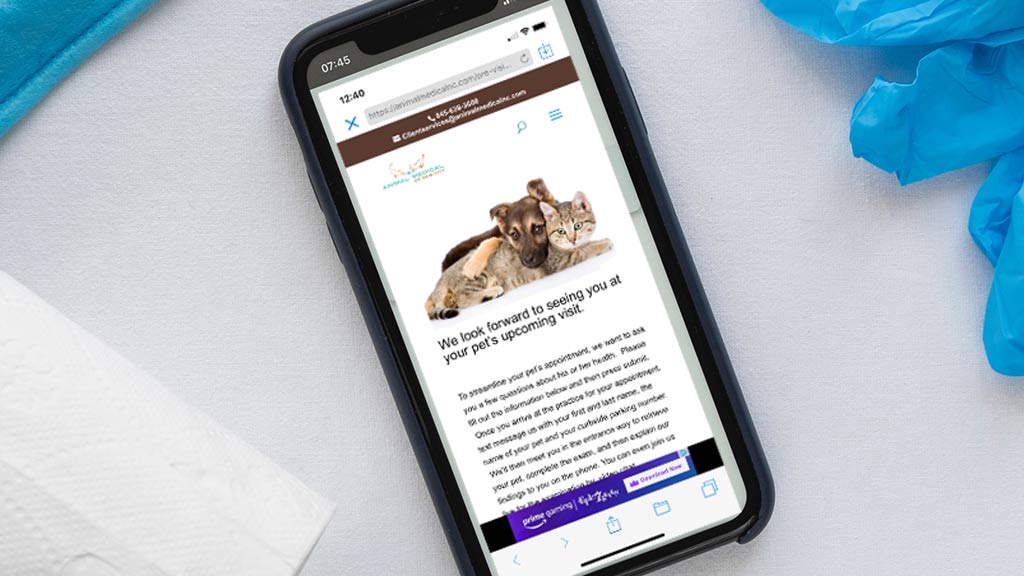In my capacity as a business advisor, I have observed dozens, if not hundreds of client exchanges in the exam room. One misunderstanding is the notion that more client education = better service.
More Client Education ≠ Better Service
Education, in the absence of relationship and context, comes off as impersonal and ‘sell-y’. Worse, everyone in the room tends to disengage when the time comes to ‘educate’ the client on routine topics like flea prevention or early disease detection. These spiels have been delivered and heard so frequently, they come off as canned.
There is a place for client education inside the four walls of your exam rooms, but it’s more important to build a relationship first, with both the client and her pet, through curiosity, active listening and empathy.
Take Time to Listen
Relationships between clients and vet professionals usually have a ruinous interloper, the dreaded computer. It’s too bad that we’ve become inured against the alienating, relationship-stopping, presence of the computer screen at both the front desk and in the exam room. Computers roadblock what should be a pleasant interaction between two people and turn it into a clinical, distanced exchange.
Don’t believe me? Travel back in time to your last doctor visit. Were the nurse’s eyes focused on you or the questions that she had to check off on her screen? Was the doctor facing you, listening to you, reacting to you…all the physical gestures we would expect from someone interested in caring for us… or was her body turned towards, and tuned into, the computer in front of her?
If your objective is to effectively educate clients, don’t practice your patter, practice paying attention. That means stopping everything else you are doing, turning towards the client, asking thoughtful questions, and reacting compassionately and thoughtfully to the responses. Don’t worry about noting every comment in the computer. Provided you jot notes down in a reasonable time frame, you will remember what you need to remember.
Pursuing education, and presumably the compliance you hope to gain from it, by focusing first on your relationship with the client, won’t be as hard as you think. In the 24 years that I have been managing veterinary hospitals, I have found that there are three things that are a consistent source of job satisfaction: working with people you like, nursing and interacting with animals, and building relationships with clients.
You can test the theory yourself. At your next employee meeting, ask everyone to imagine coming to work on the following day. Then, invite everyone to think about a moment during their shift that they anticipate will make them smile. I’m willing to bet that they cite my three answers: interacting with favorite coworkers, getting a chance to pet and hold animals, and talking to clients.
Focusing on relationship building, not client education, is more enjoyable and a better way to achieve higher compliance.
Listen for Chances to Recommend the Hospital’s Services
When I started leading, I built questions for team members to ask during the history-taking part of the exam. The list was designed to get a thorough background on the patient’s health and presenting complaint as well as to look for opportunities to upsell products and services. It’s a shameful admission, but a true one. The questions were, in a way, an attempt to lead the witness. “One-in-four dogs test positive for a tick-borne illness. Do you protect your pet against ticks?”
Since then, I’ve learned a better way to both enjoy my time with the client and to look for ways to build my business. It’s predicated on inviting the client to talk about her relationship with her pet, the pet’s place in the family, his lifestyle, and his likes and dislikes. The questions serve as a jumping off point for us to relate to one another, to grow our relationship as fellow pet owners, and as a way to look for opportunities to recommend our services. In the end, the difference between the two approaches may seem subtle, but the results are starkly different. The first approach feels clinical whereas the second approach is more conversational and, I would emphasize, genuine and more enjoyable.
Make a Strong Recommendation
Once you have gathered enough information on the pet, the family, and their lifestyle, there is no need for client education, just tell them what you think they should do. An honest tale speeds best being plainly told as the expression goes and the same is true here. You don’t need client education to underscore your credibility. If you have spent sufficient time listening to the client and expressing a genuine curiosity in her life, her family, and her pet, you will have already gained all the trust you need to have your recommendations come across as well-intended and authoritative.
Read the Client’s Body Language
If the client is confused or uninterested in your suggestion, she’ll telegraph it with her body language. She’ll look down, cut you off with a perfunctory, ‘Okay’, or appear to shut down. At that point, if you are especially eager to help, you can ask the client for more information, “How do you feel about my recommendation? Do you want to know more about my line of thinking?”
Some team members may feel this extra push for client compliance is too strong, but here is my thought:
If you have made a strong recommendation for a service that can be dismissed without any additional discussion, how valuable was the recommendation to begin with? From the client’s perspective, not making an attempt to better explain yourself may leave her feeling like you weren’t serious about the offer to begin with and ‘just trying to make more money’.
Lastly, if you have made the recommendation and the owner declines, note the exchange in the medical record.
Use Stories
When educating a client about the value of a service, tell the story of how the service worked to improve the life of another client or patient. Stories are more effective at conveying the things that matter most to clients: how the remedy improved the life of the pet, made a better health outcome, saved a client money, and the like.
Tell the Patient’s Story
Parallel to the above point is how we educate a client about a treatment plan.
Most vet professionals go straight to the treatment plan when educating clients about services and read it aloud, line by line. This isn’t education, it’s an audit. My sense is that hospital teams are attempting to be as transparent as they can about pricing, but in their attempt to explain every charge, they end up sounding as though money is the only thing that matters, especially when, as so often is the case, the employee never mention the pet’s name or wellbeing during the exchange.
When reviewing a treatment plan with a client, tell the story of the pet’s care. Explain the services as a journey of treating the patient’s emotions, safety, pain, and physical wellbeing. So, instead of reading the treatment plan as a list of invoice items:
- Catheter, 25-dollars
- Medical waste fee, 6-dollars
- Anesthesia charge, 140-dollars low end, 270-dollars high, etc.
Try this:
“Our goal is to make Rye’s procedure as safe and as comfortable as possible. From the moment she enters the hospital, we’re paying attention to her safety and how she feels. To that end, we place a catheter. This procedure is fast, nearly pain-free, and provides us the ability to give her something to mellow out her anxiety. It’s also the ideal safety measure because we can use it to immediately deliver any additional medications she may need…”
Be Consistent
One sure way to undermine client education is to have a team divided on what they believe is or is not necessary for optimal care. If you have one doctor that believes in pre-surgical bloodwork, but another that does not, you risk alienating the one with the safer approach to patient care. Just as bad, you instill in the client the sense that there are some team members that make superfluous recommendations. In cases like these, you risk the loyalty of your client base, the financial soundness of your business, and the enjoyment that some of your team members get from their work.
To ensure that everyone is making consistent recommendations, hold a standard-of-care meeting during which all doctors agree to the same approach to patient wellness. From there, branch off to commonly treated illnesses/conditions like diarrhea, vomiting, dental disease, skin masses, upper respiratory infections, and so forth. Once these standards have been agreed upon by doctors, promulgate them to the rest of the team.
Too many practices fear a standard of care meeting, worrying that it will end contentiously. Don’t fear. I have led many standard-of-care meetings in my career. Almost all doctors find them helpful. Support staff are ecstatic to be working for one hospital instead of a suite of different doctors and their specific conditions of care.
$1000
$1000 referral fee for veterinarian applicants. Sign on bonuses also available. More.
Leverage Technology
When the expectation is that every client should receive education on a matter (fasting instructions, surgery discharge or flea prevention come to mind), leverage technology to make the process consistent and efficient.
Video Record Common Instructions
For the most part, education like admission and surgery discharge instructions are always the same. Ask a team member to work with you to film the discharge instructions, then upload the clip to your YouTube or TikTok Channel and your website. Send the link out along with any electronic documentation that needs to be reviewed and signed. Remember that links can be printed as QR codes using free, online converters if you want a way to add the code to the bottom of an invoice or to a card that a client can take home after the consultation. Video recording the education that is repeated throughout every day saves time and, when hosted on your site or on your social media channels, supports search engine ranking and traffic.
Remind for What You Will Recommend
Make sure that reminder cards and emails remind for services that you will recommend at the next visit, not services which have already been rendered and are coming due again. Reminding for services that you will recommend will give you an easier time of introducing the topic and improving client compliance.
Create Electronic Pre-Visit Medical Questionnaires
At most practices, assistants or technicians start exams by taking a patient history and educating clients about the value of things like early-disease screens, parasite testing, lifestyle vaccines, and so forth. Some hospitals have streamlined the process by creating electronic medical history forms that use conditional logic. These forms can be built directly on your website or by using services like Jotform. Using conditional logic means that the form will automatically populate with educational blurbs or more questions based on whatever responses the client provides. For example, if a pet owner were to select ‘soft stool’ as one of the symptoms that the pet is experiencing, the document can immediately populate with additional questions about the frequency or color of the stool as well as a small blurb explaining why it is necessary to bring in a fecal sample.
Conditional logic forms are entirely electronic and because they are mobile responsive, can be filled out and sent through any device. Once they are received, they can be copied and pasted into the electronic medical history or printed and put in a paper chart. The help they can provide clients is nearly limitless. They can be used to direct pet owners to your online store to refill parasite prevention medication, to articles that you host on your website, or to a scheduler where clients can book their next appointment, all without ever losing the original place on the primary document.
Create a Digital Handout Library
Veterinary professionals regularly spend time teaching clients how to:
- Administer insulin
- Care for diabetic pets
- Administer subcutaneous fluids
- Manage pet obesity
- Give a pill by mouth
- Trim nails
- Express anal glands, etc.
Most veterinary professionals could effortlessly outline an article on any one of the above topics. One member of the team could then use the outline to write the full paper and upload it onto the practice’s website. Alternatively, if you’re having trouble getting started, you could ask ChatGPT how to do any of the above and then use the AI’s content to jump start the writing project, just keep in mind that some of Chat’s content may be copied from elsewhere on the web and therefore copyright protected.
Introducing a client to the written material before you give any inhouse lesson can improve comprehension and reduce the amount of time you spend teaching. Alternatively, sending the material after the education can also boost comprehension and serve as a resource for the client should they forget some of what was taught to them.
Conclusion
Somewhere along the line we were taught that more client education equals a better client service experience. This is not true. Meaningful exchanges and trust are the true source of client satisfaction. Once a trusting relationship has been established, the veterinary professional needn’t lead off with education, they only have to listen, compassionately understand, and then tell the client what they believe is best. Should the client need more information, then education can be provided ad hoc.
While the dry science part of health education is important to some, all clients respond to the stories of how treatment and care will impact the lives of their pets. When recommending a service or reviewing a treatment plan, explain it specifically in the context of the patient. Discuss how the service safeguards against harm, anxiety, and pain; and add that cost, time, and client’s concerns have also been factored into the plan. After listening to the client and examining the pet, plainly state your recommendations, then wait and watch for the client to express her thoughts.











